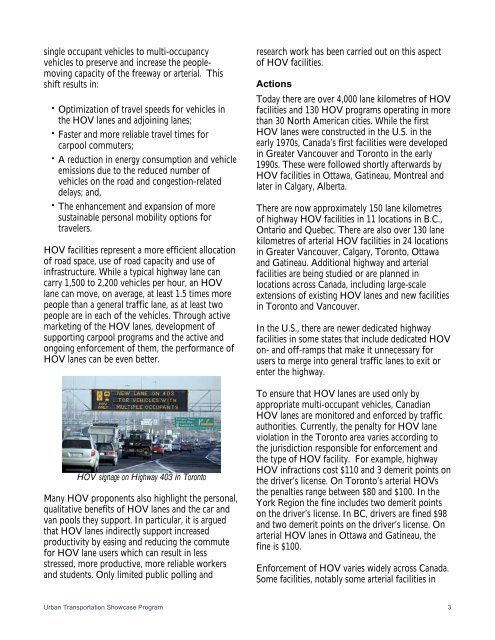High Occupancy Vehicle Lanes in Canada
High Occupancy Vehicle Lanes in Canada
High Occupancy Vehicle Lanes in Canada
Create successful ePaper yourself
Turn your PDF publications into a flip-book with our unique Google optimized e-Paper software.
s<strong>in</strong>gle occupant vehicles to multi-occupancy<br />
vehicles to preserve and <strong>in</strong>crease the peoplemov<strong>in</strong>g<br />
capacity of the freeway or arterial. This<br />
shift results <strong>in</strong>:<br />
• Optimization of travel speeds for vehicles <strong>in</strong><br />
the HOV lanes and adjo<strong>in</strong><strong>in</strong>g lanes;<br />
• Faster and more reliable travel times for<br />
carpool commuters;<br />
• A reduction <strong>in</strong> energy consumption and vehicle<br />
emissions due to the reduced number of<br />
vehicles on the road and congestion-related<br />
delays; and,<br />
• The enhancement and expansion of more<br />
susta<strong>in</strong>able personal mobility options for<br />
travelers.<br />
HOV facilities represent a more efficient allocation<br />
of road space, use of road capacity and use of<br />
<strong>in</strong>frastructure. While a typical highway lane can<br />
carry 1,500 to 2,200 vehicles per hour, an HOV<br />
lane can move, on average, at least 1.5 times more<br />
people than a general traffic lane, as at least two<br />
people are <strong>in</strong> each of the vehicles. Through active<br />
market<strong>in</strong>g of the HOV lanes, development of<br />
support<strong>in</strong>g carpool programs and the active and<br />
ongo<strong>in</strong>g enforcement of them, the performance of<br />
HOV lanes can be even better.<br />
HOV signage on <strong>High</strong>way 403 <strong>in</strong> Toronto<br />
Many HOV proponents also highlight the personal,<br />
qualitative benefits of HOV lanes and the car and<br />
van pools they support. In particular, it is argued<br />
that HOV lanes <strong>in</strong>directly support <strong>in</strong>creased<br />
productivity by eas<strong>in</strong>g and reduc<strong>in</strong>g the commute<br />
for HOV lane users which can result <strong>in</strong> less<br />
stressed, more productive, more reliable workers<br />
and students. Only limited public poll<strong>in</strong>g and<br />
research work has been carried out on this aspect<br />
of HOV facilities.<br />
Actions<br />
Today there are over 4,000 lane kilometres of HOV<br />
facilities and 130 HOV programs operat<strong>in</strong>g <strong>in</strong> more<br />
than 30 North American cities. While the first<br />
HOV lanes were constructed <strong>in</strong> the U.S. <strong>in</strong> the<br />
early 1970s, <strong>Canada</strong>’s first facilities were developed<br />
<strong>in</strong> Greater Vancouver and Toronto <strong>in</strong> the early<br />
1990s. These were followed shortly afterwards by<br />
HOV facilities <strong>in</strong> Ottawa, Gat<strong>in</strong>eau, Montreal and<br />
later <strong>in</strong> Calgary, Alberta.<br />
There are now approximately 150 lane kilometres<br />
of highway HOV facilities <strong>in</strong> 11 locations <strong>in</strong> B.C.,<br />
Ontario and Quebec. There are also over 130 lane<br />
kilometres of arterial HOV facilities <strong>in</strong> 24 locations<br />
<strong>in</strong> Greater Vancouver, Calgary, Toronto, Ottawa<br />
and Gat<strong>in</strong>eau. Additional highway and arterial<br />
facilities are be<strong>in</strong>g studied or are planned <strong>in</strong><br />
locations across <strong>Canada</strong>, <strong>in</strong>clud<strong>in</strong>g large-scale<br />
extensions of exist<strong>in</strong>g HOV lanes and new facilities<br />
<strong>in</strong> Toronto and Vancouver.<br />
In the U.S., there are newer dedicated highway<br />
facilities <strong>in</strong> some states that <strong>in</strong>clude dedicated HOV<br />
on- and off-ramps that make it unnecessary for<br />
users to merge <strong>in</strong>to general traffic lanes to exit or<br />
enter the highway.<br />
To ensure that HOV lanes are used only by<br />
appropriate multi-occupant vehicles, Canadian<br />
HOV lanes are monitored and enforced by traffic<br />
authorities. Currently, the penalty for HOV lane<br />
violation <strong>in</strong> the Toronto area varies accord<strong>in</strong>g to<br />
the jurisdiction responsible for enforcement and<br />
the type of HOV facility. For example, highway<br />
HOV <strong>in</strong>fractions cost $110 and 3 demerit po<strong>in</strong>ts on<br />
the driver’s license. On Toronto’s arterial HOVs<br />
the penalties range between $80 and $100. In the<br />
York Region the f<strong>in</strong>e <strong>in</strong>cludes two demerit po<strong>in</strong>ts<br />
on the driver’s license. In BC, drivers are f<strong>in</strong>ed $98<br />
and two demerit po<strong>in</strong>ts on the driver’s license. On<br />
arterial HOV lanes <strong>in</strong> Ottawa and Gat<strong>in</strong>eau, the<br />
f<strong>in</strong>e is $100.<br />
Enforcement of HOV varies widely across <strong>Canada</strong>.<br />
Some facilities, notably some arterial facilities <strong>in</strong><br />
Urban Transportation Showcase Program 3
















